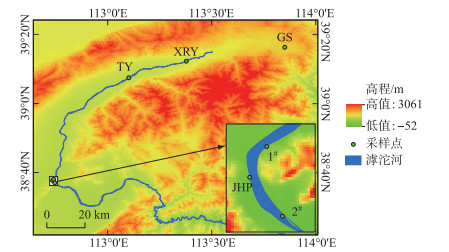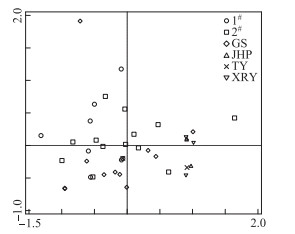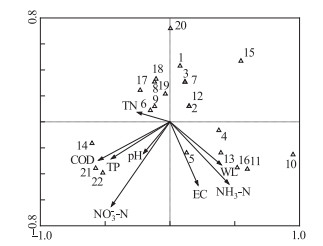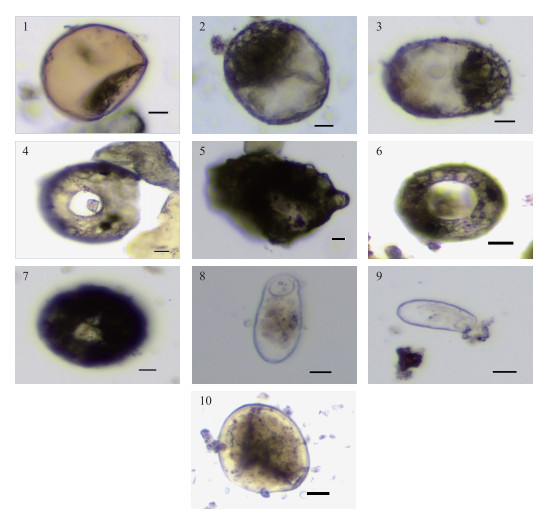有壳变形虫是一类有壳的单细胞根足类原生动物,主要在淡水环境如河流、湖泊、水库、沼泽等潮湿的环境中生活,是淡水生态系统的重要组成成分[1-5]. 有壳变形虫个体微小,一般在20~250 μm之间,壳体大部分是由自体分泌粘性有机物胶结周围砂粒等物质组成,具有良好的抗腐蚀性,对环境变化响应敏感,被认为是湿地生态、湖泊富营养化和酸化的非常重要的指标生物,在生态学研究中具有独特而重要的应用价值[2, 4-5]. 近年来有壳变形虫研究已经成为了国内外的研究热点,主要集中于对有壳变形虫的分类学[6-12]、生态学[12-22]、生物地理学[23-25]和古生态学[26-32]等方面的研究,国内学者对有壳变形虫的研究工作集中于东北泥炭地[13, 33-42]、长江流域湿地[43]和云南湿地[12, 23-24, 44]等地区,取得了显著的研究成果,但研究区域相对集中,缺乏对中国不同区域不同生境湿地有壳变形虫的生态学研究.
山西省属于高原性内陆地区,滹沱河作为山西的第二大河流,河流湿地对环境变化响应敏感,是水生生物多样性的主要载体,是现代生态学研究的理想场所[45]. 研究学者在山西滹沱河湿地主要开展了植物相关的研究且集中于2000-2006年[45-49],对其它生物的研究还基本处于空白状态,其中包括有壳变形虫,目前对该流域湿地生态系统缺乏系统的认知. 因此对山西滹沱河湿地有壳变形虫物种组成、多样性及与环境因子关系的研究是非常有意义的. 本研究以山西滹沱河流域湿地为研究对象,对有壳变形虫进行现代生态学研究,探讨有壳变形虫物种组成、多样性及与水环境因子的关系,为我国湿地有壳变形虫研究进行补充和完善,为山西河湖湿地生态环境管理保护和恢复提供理论支撑和科学依据.
1 研究方法 1.1 研究区滹沱河是山西省的第二大河流,河流湿地是山西省重要的湿地类型. 滹沱河发源于山西省繁峙县横涧乡秦戏山桥儿沟,流经繁峙、代县、忻州、原平、定襄、五台、盂县出山西省境,山西省内流域面积14284 km2,长度330 km[49]. 主要支流有阳武河、云中河、牧马河和清水河等,呈羽状排列. 流域湿地的土壤主要为冲积土、草甸土、沼泽土和盐渍土[49].
滹沱河流域属于暖温带大陆性季风气候,夏季暖热多雨,冬季寒冷干燥. 年平均气温为8.0~9.0℃,7月最热,平均气温为22.5~23.5℃,1月最冷,平均气温为-10.0~-9.0℃,年降水量400~450 mm,7-8月份降水量占全年的53 % 左右[49].
1.2 野外样品采集本研究主要在滹沱河流域的孤山水库(GS:39°16′5″N,113°50′41″E)、下茹越水库(XRY:39°11′53″N,113°22′19″E)、沱阳村(TY:39°7′15″N,113°5′44″E)、界河铺(JHP:38°37′44″N,112°43′55″E)、滹沱河1号桥(1#:38°38′14″N,112°44′17″E)和2号桥(2#:38°36′59″N,112°44′38″E)进行样品采集,具体的采样点位置见图 1. 沿着水位梯度进行沉积样品的采集,采自表层3 cm样品2~3个,将其混合成1个样品装入自封袋中,做好标记带回实验室以待分析,共采集52个沉积样品(其中GS:12个样品;XRY:3个样品;TY:5个样品;JHP:3个样品;1#:16个样品;2#:13个样品),采样过程中记录每个采样点的经度、纬度和海拔高度. 采集沉积样品的同时使用聚乙烯瓶采集水样品,每个样品采集1 L,共采集47个水样,做好标记带回实验室在4℃条件下冷藏保存,同时测量每个采样点的水位(WL)并进行记录.

|
图 1 滹沱河湿地采样点分布 Fig.1 Location of sampling sites in Hutuohe wetlands |
有壳变形虫的提取主要参考Booth等的方法[50],具体步骤如下:首先取约3~5 g土壤样品放入干净的盛有蒸馏水的烧杯(200 mL)中,用干净的玻璃棒轻轻搅拌10 min以使有壳虫从基质中分离出来,然后过300和20 μm的筛子去除掉大颗粒、微粒和矿物碎屑,将20~300 μm之间的有壳变形虫壳体冲洗到50 mL离心管中,用蒸馏水定容到50 mL. 在200X-400X显微镜下进行鉴定和计数,每个样品至少要鉴定150个壳体. 若有壳变形虫壳体较少,则至少需要鉴定6个载玻片[5, 50],本研究所有样品均鉴定大于6个载玻片. 有壳变形虫的种类鉴定和命名主要参考Charman[5]和杨军等[10-11]已发表的文献及网站https://www.arcella.nl.
1.4 水样品及沉积样品理化指标测定将水样品进行过滤除去杂质后用于测定水质指标,每个指标数据重复测定3次,取平均值作为测定值. 其中pH值用玻璃电极法测定;电导率(EC)用电导率仪测定;总氮(TN)、硝态氮(NO3--N)、总磷(TP)浓度采用SMARCHEM 450全自动间断化学分析仪测定;化学需氧量(COD)采用重铬酸钾标准法测定;氨氮(NH3-N) 浓度采用纳氏比色法测定.
取一份沉积样品使用H2O2和HCl处理分别去除有机物和碳酸盐后,使用马尔文Mastersizer 3000激光粒度仪进行粒度测定. 另一份沉积样品风干过100目(150 μm)筛,用HCl去除无机碳后使用德国耶拿multi C/N仪进行总有机碳(TOC)测定,乘以系数1.724得到有机质含量[51].
1.5 数据统计分析本研究使用Excel软件对统计的有壳变形虫种类和个体数量数据进行丰富度指数和Shannon-Wiener多样性指数计算. Shannon-Wiener多样性指数的计算公式如下[37]:
| $ H^{\prime}=-\sum P_{i} \cdot \ln P_{i} $ | (1) |
式中,Pi为第i个物种的丰度.
使用CANOCO软件对有壳变形虫物种数据和环境因子数据进行非度量多维尺度分析(non-metric multidimensional scaling,NMDS)、除趋势对应分析(detrended correspondence analysis,DCA)和典型对应分析(canonical correspondence analysis,CCA)等排序分析. 本研究仅对41个含有壳变形虫的沉积样品进行排序分析,排序过程中对物种数据进行对数转换,对稀有种进行降权处理,环境因子数据不进行转换.
2 研究结果 2.1 有壳变形虫种类组成及多样性本研究6个不同生境的52个土壤样品中共鉴定有壳变形虫20种,隶属于7科10属,有壳变形虫种类、丰度和频数见表 1. 本研究鉴定的有壳变形虫均为其它研究中的常见种,但整体来看,样品中壳体数较少,特别是沱阳和界河铺湿地样品中的壳体较少. 其中相对丰度大于3 % 的物种有斜口三足虫、顶足法帽虫、砂壳虫、线条三足虫、小匣三角嘴虫、网匣壳虫和半球表壳虫,其中斜口三足虫的相对丰度最大,为23.4 %. 而盘状表壳虫、弯凸表壳虫、卵圆隐砂壳虫、明亮砂壳虫(Difflugia lucida)、收音截口虫、小茄壳虫、凤蝶茄壳虫、亚黄茄壳虫和平直三足虫物种的相对丰度则不足1 %. 本研究中没有一种有壳变形虫物种在全部样品中出现,各样品中出现频数最多的为顶足法帽虫,在16个样品中出现;盘状表壳虫、弯凸表壳虫、明亮砂壳虫、凤蝶茄壳虫和小茄壳虫5个物种仅在一个样品中出现. 泥炭地常见种苔藓鳞盖虫(Assulina muscorum)和半空鳞盖虫(Assulina seminulum)在本研究中没有记录,说明有些有壳变形虫物种只在特种湿地生境中生存. 本研究中各采样点的有壳变形虫物种丰富度和多样性呈现明显的差异(表 2),其中孤山水库和滹沱河2号桥湿地的有壳变形虫物种丰富度和多样性较高,而沱阳、界河铺和下茹越湿地的有壳变形虫物种丰富度和多样性则较低.
| 表 1 有壳变形虫种类组成、相对丰度和频数 Tab. 1 The species composition, relative abundance and frequency of testate amoebae taxa |
| 表 2 有壳变形虫物种丰富度和多样性指数 Tab. 2 Species richness and diversity index of testate amoebae |
对滹沱河流域所有采样点有壳变形虫进行了NMDS分析(图 2). 从NMDS排序图中看出,孤山水库、沱阳、下茹越、滹沱河1号桥和2号桥6个采样区域的样点分布各不相同,部分采样点在排序图上有重叠,表明采样点之间具有相似的有壳变形虫物种组成,但重叠样点并不多,说明本研究各采样点的有壳变形虫物种组成相似性较弱,存在明显的差异. 界河铺和下茹越的采样点在排序图中相对比较集中,距离较近,表明采样点之间具有相似的生境类型. 滹沱河1号桥的采样点主要分布在排序图的左侧,2号桥的采样点分布相对分散,孤山水库采样点则集中分布在排序图的下侧,样点在排序图上的分布反映出不同生境下的有壳变形虫群落结构有差异.

|
图 2 滹沱河湿地采样点NMDS排序图 Fig.2 Sample ordination plot of NMDS of Hutuohe wetlands |
为探讨滹沱河流域有壳变形虫和水环境因子之间的关系,首先使用CANOCO软件对有壳变形虫物种数据进行DCA排序分析(表 3). 根据DCA排序结果分析的梯度长度值判断采用单峰模型还是线性模型,若DCA排序4个轴中最大梯度长度>4,选择单峰模型;若 < 3,则选择线性模型;若介于3~4之间,则2种模型均可使用. 从表 3中可以看出,4个轴中最大特征值为8.312,大于4,因此选用单峰模型CCA对有壳变形虫数据和环境因子数据进行排序分析.
| 表 3 有壳变形虫数据的DCA分析结果 Tab. 3 Results of DCA for testate amoebae |
滹沱河湿地有壳变形虫和环境因子CCA排序分析结果见表 4和图 3. 表 4显示第1轴对物种变化及物种-环境因子变化的解释量最大,分别为8.2 % 和31.9 %,明显高于其它3个排序轴,因此第1排序轴可以反映有壳变形虫群落和环境关系的主要特征. 前4轴对物种变化的解释量为20.0 %,对物种-环境因子变化的解释量为77.4 %. 从CCA排序图可以看出,COD、NH3-N和NO3--N线段较长,且与轴1的夹角相对较小,表明这3个环境因子对有壳变形群落分布有显著影响;而TN和pH与轴1的夹角较小且线段较短,表明TN和pH对有壳变形虫群落分布没有明显的影响. 因此根据不同的环境因子对有壳变形虫群落分布的解释量按重要性从大到小依次排序为:NO3--N>COD>NH3-N>WL>EC>TN>TP>pH,其中NO3--N的解释量最大,为19.6 %,其次为COD,解释量为17.3 %,解释量最小的环境因子为pH,为8.6 %.
| 表 4 有壳变形虫与环境因子数据的CCA分析结果 Tab. 4 Results of CCA for testate amoebae species and environment factors |

|
图 3 滹沱河湿地有壳变形虫与水环境因子的CCA排序图 (△表示有壳变形虫种类编号,详见表 1) Fig.3 Ordination plot of CCA between testate amoebae species and environment factors in Hutuohe wetlands |
本研究鉴定的滹沱河湿地有壳变形虫物种为20种,隶属于7科10属,均为其它国内外研究中的常见种,但有壳变形虫物种数相较于中国其它湿地物种种类较少(表 5),分析导致产生这种现象的原因主要有3点. 其一为本研究设置的采样区域包含的生境类型差异不是很大,采集的样本量相对较少,因此鉴定的有壳变形虫物种数量相对较少. 其二为本研究采用的有壳变形虫鉴定依据主要为Charman等[5]的文献和其它一些学者发表文献中的图谱[10, 33, 37],采用了相对保守的分类方法,仅在光学显微镜下清晰可见且具有明显的鉴定特征时才被记录. 在显微镜下进行鉴定时对有壳变形虫形态特征相似的物种进行合并,命名为“type”[52]. 该合并鉴定统计方法目前被很多研究学者认可,这样也便于不同区域研究结果进行对比分析,但会导致鉴定的有壳变形虫物种数量变少. 其三为各研究区域湿地所处的营养状态不同,贫营养状态基本不会产生有壳变形虫,中营养及富营养状态有壳变形虫数量最大,营养过剩不利于有壳变形虫的生长繁殖,因此数量也较少[1, 12, 53]. 本研究滹沱河湿地水质指标见表 6,参照地表水环境质量标准限值,孤山水库、下茹越水库和1号桥COD值均大于40 mg/L,属于Ⅴ类水以外,2号桥采样点的水质为Ⅴ类水,界河铺和沱阳的水质为Ⅳ类水;所有采样点的TN浓度均超Ⅴ类,且超标很多;TP浓度都很低,均为Ⅲ类或优于Ⅲ类水质;pH都处于6~9之间;NH3-N浓度均 < 0.15 mg/L,均未超Ⅰ类水质. 通过对比分析,本研究所调查的滹沱河水体中的TN和COD超标严重,属于营养过剩,导致有壳变形虫物种数量相较于中营养及富营养的泥炭湿地的种类少.
| 表 5 不同地区有壳变形虫物种数对比 Tab. 5 Comparison of testate amoebae species number in different regions |
| 表 6 滹沱河湿地水质指标 Tab. 6 Water quality indexes of Hutuohe wetlands |
本研究6个采样区域之间有壳变形虫物种丰富度和多样性存在较大的差异(表 2),这主要与沉积介质有关. 孤山水库湿地和滹沱河2号桥的沉积物为壤土,有机质含量较高,分别为34.10和24.28 g/kg(表 7),适合有壳变形虫生存,有壳变形虫物种丰富度和多样性都较高. 界河铺采样点的沉积物为壤质砂土,有机质含量最低(3.85 g/kg)(表 7),有壳变形虫的物种丰富度和多样性指数均为最低,说明壤质砂土最不利于有壳变形虫生存. 下茹越水库、沱阳和滹沱河1号桥采样点沉积物为砂质壤土,有机质含量相对壤土较低,有壳变形虫的丰富度和多样性指数也相对较低,说明砂质壤土也不适合有壳变形虫的生存,该研究结果与前人的研究结果一致[15]. 通过有壳变形虫多样性与环境因子相关性分析得出,有壳变形虫多样性与有机质呈现显著正相关关系(R=0.904),与砂粒呈显著负相关关系(R=-0.831)(表 8). 因此,滹沱河湿地沉积物质地和有机质含量对有壳变形虫的物种丰富度和多样性有显著影响,砂粒含量越低,有机质含量越高,有壳变形虫的丰富度和多样性越高.
| 表 7 滹沱河湿地沉积物指标(平均值) Tab. 7 Sediment indexes of Hutuohe wetlands (mean value) |
| 表 8 沉积物中有壳变形虫多样性指数与环境因子之间的关系 Tab. 8 The relationships between testate amoebae biodiversity and environment factors of sediment samples |
探究生物物种与环境因子之间的关系找出关键环境因子,是建立生物-环境因子转换函数的基础. 目前国内外很多学者对湿地有壳变形虫与环境因子关系进行了很多研究[34, 43, 55],找出影响有壳变形虫物种组成及分布的关键环境因子,并建立有壳变形虫-环境因子转换函数[33, 52, 56-57],进而定量重建泥炭地古水位[26, 28-30]. 国内外关于有壳变形虫的现代生态学研究得出水位埋深、泥炭湿度和pH是影响有壳变形虫物种组成及分布的主要环境因子,其中水位埋深又是最关键的环境因子[36, 52, 54]. 本研究结果表明,影响滹沱河湿地有壳变形虫物种组成及分布的环境因子重要性排序为:NO3--N >COD >NH3-N >WL>EC>TN>TP>pH,其中NO3--N的解释量最大为19.6 %,为关键环境影响因子,其次为COD和NH3-N,水位在8个环境因子中排列第4,解释量为11.2 %,而pH的解释量最小为8.6 %,该研究结果与前人对泥炭地有壳变形虫研究结果不一致[33, 41, 52],但与神农架大九湖的研究结果相似[17],表明对于不同类型的湿地(如河流湿地、湖泊湿地和沼泽湿地),影响其有壳变形虫物种群落分布的关键环境因子不同,另一原因可能与人类活动有关.
本研究6个采样区域周围都有农作物种植,作物种植过程中施用化肥和农药等产品,会对水体中氮、磷和有机污染物的含量产生影响,进而影响湿地生态系统组成及功能. 化肥和农药的使用使得水体TN和COD含量超标严重,进而影响有壳变形虫的物种组成及分布. 值得思考的是,虽然TN浓度较高,但NH3-N和NO3--N浓度较低,CCA排序结果显示对滹沱河湿地有壳变形虫物种变化解释量最大的为NO3--N(19.6 %),其次为NH3-N(15.4 %),而TN的解释量则相对较低,为8.9 %,产生这一结果的原因尚不清楚,还需要进一步的研究和讨论.
4 结论与展望本研究对滹沱河湿地有壳变形虫物种组成及与环境因子关系进行初步研究,结果显示有壳变形虫均为国内外研究中的常见种,但种类数量相对较少,为20种,其中优势种为斜口三足虫、顶足法帽虫和线条三足虫;沉积物质地和有机质含量对有壳变形虫物种组成及多样性有显著影响;NO3--N和COD是影响有壳变形虫种类组成和分布的关键环境因子,本研究结果可为将来山西不同类型湿地有壳变形虫现代生态学研究提供借鉴.
目前对山西不同类型湿地的有壳变形虫现代生态学研究还非常缺乏,本研究虽然取得了一定的结果,但还存在一些问题,未来可以加强以下方面的研究:在山西扩大对不同类型的湿地的采样范围及采样点,加强有壳变形虫现代生态学研究;增加环境因子,如土壤元素、矿物和重金属等物质组成对有壳变形虫群落组成及分布的影响,并找出关键环境影响因子,进而为湿地多样性保护、湿地管理和修复等方面提供有效的指示信息.
5 附录附图Ⅰ见电子版(DOI: 10.18307/2022.0420).

|
附图Ⅰ 本文记录的部分有壳变形虫种类(1.半球表壳虫(Arcella hemisphaerica); 2.网匣壳虫(Centropyxis cassis type); 3.片口匣壳虫(Centropyxis platystoma type); 4.小口圆壳虫(Cyclopyxis Kahli); 5.尖顶砂壳虫(Difftugia acuminate type); 6.顶足法帽虫(Phryganella acropodia); 7.小匣三角嘴虫(Trigonopyxis arcula); 8.斜口三足虫(Trinema enchelys);9.线条三足虫(Trinema lineare); 10.亚黄茄壳虫(Hyalosphenia subflava). 图中比例尺代表 10 μm.) AttachedFigI Some species of shelled amoeba recorded in this paper |
| [1] |
Wang PX, Min QB. On the paleoenvironmental significance of Thecamoebians in the Quaternary studies of China. Acta Micropalaeontologica Sinica, 1987, 4(4): 345-349, 447. [汪品先, 闵秋宝. 有壳变形虫在我国第四纪古环境研究中的意义. 微体古生物学报, 1987, 4(4): 345-349, 447.] |
| [2] |
Qin YM, Xie SC, Gu YS et al. An excellent indicator for quaternary paleoenvironmental reconstructions—Advances in the study of Testate Amoebae(Thecamoebians, Arcellacean). Advances in Earth Science, 2008, 23(8): 803-812. [秦养民, 谢树成, 顾延生等. 第四纪环境重建的良好代用指标——有壳变形虫记录与古生态学研究进展. 地球科学进展, 2008, 23(8): 803-812. DOI:10.3321/j.issn:1001-8166.2008.08.003] |
| [3] |
Xie SC, Huang XY, Yang H et al. An overview on microbial proxies for the reconstruction of past global environmental change. Quaternary Sciences, 2013, 33(1): 1-19. [谢树成, 黄咸雨, 杨欢等. 示踪全球环境变化的微生物代用指标. 第四纪研究, 2013, 33(1): 1-19. DOI:10.3969/j.issn.1001-7410.2013.01.01] |
| [4] |
Mitchell EAD, Charman DJ, Warner BG. Testate amoebae analysis in ecological and paleoecological studies of wetlands: Past, present and future. Biodiversity and Conservation, 2008, 17(9): 2115-2137. DOI:10.1007/s10531-007-9221-3 |
| [5] |
Charman DJ, Hendon D, Woodland WA. The identification of testate amoebae (Protozoa: Rhizopoda) in peats: Quaternary Research Association Technical Guide No. 9. London: Quaternary Research Association, 2000: 1-147.
|
| [6] |
McKeown MM, Mitchell EAD, Amesbury MJ et al. The testate amoebae of New Zealand: A checklist, identification key and assessment of biogeographic patterns. European Journal of Protistology, 2021, 81: 125789. DOI:10.1016/j.ejop.2021.125789 |
| [7] |
Payne RJ, Mitchell EAD. How many is enough? Determining optimal count totals for ecological and palaeoecological studies of testate amoebae. Journal of Paleolimnology, 2009, 42(4): 483-495. DOI:10.1007/s10933-008-9299-y |
| [8] |
Gong J, Xu YR, Xue JT et al. Morphological characters and ecogergraphical significance of testate amobae Nebela jiuhuensis. Quateranry Sciences, 2018, 38(4): 1050-1056. [巩静, 许元韧, 薛建涛等. 九湖梨壳虫(Nebela jiuhuensis)的形态特征及其生态地理学意义. 第四纪研究, 2018, 38(4): 1050-1056.] |
| [9] |
Qin YM, Zhang WJ, Li HK et al. Note on the taxonomy of testate amoebae and their applications in ecology and palaeoecology of China, with particular reference to genus Argynnia Vucetich, 1974. Quaternary Sciences, 2011, 31(6): 1060-1066. [秦养民, 张文静, 李鸿凯等. 中国有壳变形虫Argynnia(Vucetich, 1974)属的修订及若干环境重建问题探讨. 第四纪研究, 2011, 31(6): 1060-1066. DOI:10.3969/j.issn.1001-7410.2011.06.13] |
| [10] |
Yang J. Taxonomy and ecology of freshwater testate amoebae from China[Dissertation]. Wuhan: Institute of Hydrobiology, Chinese Academy of Sciences, 2006. [杨军. 中国淡水有壳肉足虫分类与生态学研究[学位论文]. 武汉: 中国科学院水生生物研究所, 2006. ]
|
| [11] |
Yang J, Feng WS, Miao W. A taxonomic catalogue of freshwater and soil testacea in China with a discussion of their faunal similarity. Acta Hydrobiologica Sinica, 2004, 28(4): 426-433. [杨军, 冯伟松, 缪炜. 中国淡水与土壤有壳肉足虫最新分类名录及其区系分析. 水生生物学报, 2004, 28(4): 426-433. DOI:10.3321/j.issn:1000-3207.2004.04.017] |
| [12] |
Yang J, Zhang WJ, Feng WS et al. Freshwater testate amoebae of nine Yunnan plateau lakes, China. Journal of Freshwater Ecology, 2005, 20(4): 743-750. DOI:10.1080/02705060.2005.9664798 |
| [13] |
Li HK, Wang SZ, Bu ZJ et al. The testate amoebae in Sphagnum peatlands in Changbai mountains. Wetland Science, 2010, 8(3): 249-255. [李鸿凯, 王升忠, 卜兆君等. 长白山区典型泥炭藓沼泽的有壳变形虫. 湿地科学, 2010, 8(3): 249-255.] |
| [14] |
Qin YM, Xie SC. Moss-dwelling testate amoebae and their community in Dajiuhu peatland of Shennongjia Mountains, China. Journal of Freshwater Ecology, 2011, 26(1): 3-9. DOI:10.1080/02705060.2011.553810 |
| [15] |
Bobrov A, Mazei YR, Chernyshov V et al. Testate amoebae communities from some freshwater and soil habitats in China (Hubei and Shandong Provinces). Frontiers of Earth Science, 2012, 6(1): 1-9. DOI:10.1007/s11707-012-0310-6 |
| [16] |
Mazei Y, Malysheva EA, Lapteva EM et al. The role of the floodplain gradient in structuring of testate amoebae communities in the Ilych River. Biology Bulletin, 2012, 39(4): 368-374. DOI:10.1134/S1062359012040061 |
| [17] |
Qin YM, Payne RJ, Gu YS et al. Ecology of testate amoebae in Dajiuhu peatland of Shennongjia Mountains, China, in relation to hydrology. Frontiers of Earth Science, 2012, 6(1): 57-65. DOI:10.1007/s11707-012-0307-1 |
| [18] |
Song LH, Li HK, Wang KH et al. Seasonal dynamics in the community structure and trophic structure of testate amoebae inhabiting the Sanjiang peatlands, Northeast China. European Journal of Protistology, 2018, 63: 51-61. DOI:10.1016/j.ejop.2018.01.005 |
| [19] |
Wang WP, Ren KX, Chen HH et al. Seven-year dynamics of testate Amoeba communities driven more by stochastic than deterministic processes in two subtropical reservoirs. Water Research, 2020, 185: 116232. DOI:10.1016/j.watres.2020.116232 |
| [20] |
Song LH, Chang L, Zhang SQ et al. Warming threatens the microbial communities in middle-high latitude peatland: Evidence from testate amoebae. Soil Biology and Biochemistry, 2021, 153: 108105. DOI:10.1016/j.soilbio.2020.108105 |
| [21] |
Qin YM, Puppe D, Zhang LH et al. How does Sphagnum growing affect testate Amoeba communities and corresponding protozoic Si pools results from field analyses in SW China. Microbial Ecology, 2021, 82(2): 459-469. DOI:10.1007/s00248-020-01668-6 |
| [22] |
Qin YM, Payne R, Yang XD et al. Testate amoebae as indicators of water quality and contamination in shallow lakes of the Middle and Lower Yangtze Plain. Environmental Earth Sciences, 2016, 75(7): 1-11. DOI:10.1007/s12665-016-5442-7 |
| [23] |
Yang J, Zhang WJ, Feng WS et al. Geographical distribution of testate amoebae in Tibet and northwestern Yunnan and their relationships with climate. Hydrobiologia, 2006, 559(1): 297-304. DOI:10.1007/s10750-005-9400-8 |
| [24] |
Yang J, Zhang WJ, Shen YF. Relationships between testate amoebae assemblages (Protozoa) and geographic factors in Yunnan plateau lakes, China. Journal of Freshwater Ecology, 2009, 24(3): 437-443. DOI:10.1080/02705060.2009.9664316 |
| [25] |
Qin YM, Xie SC, Smith HG et al. Diversity, distribution and biogeography of testate amoebae in China: Implications for ecological studies in Asia. European Journal of Protistology, 2011, 47(1): 1-9. DOI:10.1016/j.ejop.2010.09.004 |
| [26] |
Li YM, Li HK, Dong YM. Quantitative reconstruction of the water table changes during the last 2000 years from laolike peatland, Changbai mountains. Quaternary Sciences, 2020, 40(5): 1170-1179. [李艳梅, 李鸿凯, 董彦民. 长白山老里克泥炭地过去2000年以来古水位定量重建. 第四纪研究, 2020, 40(5): 1170-1179.] |
| [27] |
Bysouth D, Finkelstein SA. Linking testate Amoeba assemblages to paleohydrology and ecosystem function in Holocene peat records from the Hudson Bay Lowlands, Ontario, Canada. The Holocene, 2021, 31(3): 457-468. DOI:10.1177/0959683620972792 |
| [28] |
Qin YM, Zhang LH, Swindles GT et al. A~40-year paleoenvironmental record from the Swan Oxbow, Yangtze River, China, inferred from testate amoebae and sedimentary pigments. Journal of Paleolimnology, 2021, 66(1): 29-40. DOI:10.1007/s10933-021-00183-z |
| [29] |
Liu YF, Li HK, Zhao HY et al. The variations of surface wetness recorded by multi-proxies in Yuanchi peatland of the Changbai Mountains from 1962 to 2008. Chinese Journal of Applied Ecology, 2021, 32(2): 477-485. [刘玉芳, 李鸿凯, 赵红艳等. 多指标记录的1962-2008年长白山园池泥炭地地表湿度变化. 应用生态学报, 2021, 32(2): 477-485. DOI:10.13287/j.1001-9332.202102.008] |
| [30] |
Li S. Environmental changes during last 1500 years in Johnville Peatland, Quebec, Canada[Dissertation]. Changchun: Northeast Normal University, 2018. [李帅. 加拿大魁北克省Johnville泥炭地1500年来的环境变化[学位论文]. 长春: 东北师范大学, 2018. ]
|
| [31] |
Payne RJ, Babeshko KV, van Bellen S et al. Significance testing testate Amoeba water table reconstructions. Quaternary Science Reviews, 2016, 138: 131-135. DOI:10.1016/j.quascirev.2016.01.030 |
| [32] |
Qin YM, Li HK, Mazei YR et al. Developing a continental-scale testate Amoeba hydrological transfer function for Asian peatlands. Quaternary Science Reviews, 2021, 258: 106868. DOI:10.1016/j.quascirev.2021.106868 |
| [33] |
Li HK. Development testate amoeba-based transfer functions of environmental variable in peatlands in the Changbai Mountains of Northeast China[Dissertation]. Xi'an: Institute of Earth Environment, Chinese Academy of Sciences, 2009. [李鸿凯. 长白山区泥炭地有壳变形虫-环境因子转换函数模型研究[学位论文]. 西安: 中国科学院地球环境研究所, 2009. ]
|
| [34] |
Li HK, Bu ZJ, Wang SZ et al. Environmental implications of the modern testate amoebae in the peatlands in Changbai Mountains. Quaternary Sciences, 2009, 29(4): 817-824. [李鸿凯, 卜兆君, 王升忠等. 长白山区泥炭地现代有壳变形虫环境意义探讨. 第四纪研究, 2009, 29(4): 817-824. DOI:10.3969/j.issn.1001-7410.2009.04.18] |
| [35] |
Jiao WJ. Development testate amoebae-environment varible transfer function in sphagnum-dominated peatlands in Xiaoxing'an Moutains, Northeast China[Dissertation]. Changchun: Northeast Normal University, 2012. [焦文建. 小兴安岭泥炭藓泥炭地有壳变形虫—环境因子转换函数模型研究[学位论文]. 长春: 东北师范大学, 2012. ]
|
| [36] |
Li HK, Li WW, Pu YB et al. Building transfer functions between testate Amoeba and environmental variables with'rioja' Package. Scientia Geographica Sinica, 2013, 33(8): 1022-1028. [李鸿凯, 李微微, 蒲有宝等. 应用rioja软件包建立有壳变形虫-环境因子转换函数. 地理科学, 2013, 33(8): 1022-1028.] |
| [37] |
Song LH. Biodiversity of testate amoebae and their indicating role in palaeohydrological recontruction in peatlan in Sanjiang Plain[Dissertation]. Changchun: Northeast Institute of Geography and Agroecology, Chinese Academy of Sciences, 2015. [宋理洪. 三江平原泥炭沼泽有壳变形虫多样性及其在古水位重建中的作用[学位论文]. 长春: 中国科学院东北地理与农业生态研究所, 2015. ]
|
| [38] |
Song LH, Yan XM, Wang KH et al. Nitrogen input altered testate amoebae community in peatland of Sanjiang Plain, Northeast China. Chinese Journal of Applied Ecology, 2015, 26(2): 563-569. [宋理洪, 闫修民, 王可洪等. 外源氮输入改变三江平原泥炭沼泽有壳变形虫群落结构. 应用生态学报, 2015, 26(2): 563-569. DOI:10.13287/j.1001-9332.20141203.008] |
| [39] |
Zhang SP. Multi-proxy record of water level variability from three high-altitude peatlands in Changbai Mountains[Dissertation]. Changchun: Northeast Normal University, 2015. [张思鹏. 多指标记录的长白山高海拔泥炭地表面干湿变化[学位论文]. 长春: 东北师范大学, 2015. ]
|
| [40] |
Zhu ZQ. Peatlands hydrological quantitative reconstruction based on testate amoebae in Daxing'an Mountains[Dissertation]. Changchun: Northeast Normal University, 2015. [朱忠秋. 基于有壳变形虫的大兴安岭泥炭地水位定量重建[学位论文]. 长春: 东北师范大学, 2015. ]
|
| [41] |
Li S, Li HK, Wang SZ et al. The quanitative reconstruction of the paleo-water table of Luoguhe peatland in Daxing'an Mountains based on testate amoebae assemblages. Quaternary Sciences, 2017, 37: 1403-1411. [李帅, 李鸿凯, 王升忠等. 基于有壳变形虫的大兴安岭洛古河泥炭沼泽古水位定量重建. 第四纪研究, 2017, 37: 1403-1411. DOI:10.11928/j.issn.1001-7410.2017.06.22] |
| [42] |
Bao KS, Xing W, Song LH et al. A 100-year history of water level change and driving mechanism in Heilongjiang River basin wetlands. Quaternary Sciences, 2018, 38(4): 981-995. [鲍锟山, 邢伟, 宋理洪等. 黑龙江流域湿地过去百年水位变化历史及驱动机制. 第四纪研究, 2018, 38(4): 981-995.] |
| [43] |
Qin YM, Wang HL, Zhang QF et al. Response of testate amoebae community to water chemistry in peatlands near the middle reach of Yangtze River. Quaternary Sciences, 2013, 33(1): 26-33. [秦养民, 王翰林, 张千帆等. 长江中游泥炭湿地有壳变形虫空间分布及其对水化学因子的响应. 第四纪研究, 2013, 33(1): 26-33. DOI:10.3969/j.issn.1001-7410.2013.01.03] |
| [44] |
Yang J, Zhang WJ, Feng WS et al. Testate amoebae (Protozoa: Rhizopoda) from northwest Yunnan, China. Journal of Freshwater Ecology, 2005, 20(3): 583-590. DOI:10.1080/02705060.2005.9664774 |
| [45] |
Wu DL. Study on ecology of wetland vegetation in Hutuo river vally, Shanxi[Dissertation]. Taiyuan: Shanxi University, 2003. [吴东丽. 山西滹沱河流域湿地植被生态学研究[学位论文]. 太原: 山西大学, 2003. ]
|
| [46] |
Zhang F, Gao CL, Shangguan TL et al. A study on the biomass of Typha angustifolia communities in hutuo rivers wetlands, Shanxi. Journal of Shanxi University: Natural Science Edition, 2000, 23(4): 347-349. [张峰, 高翠莲, 上官铁梁等. 滹沱河湿地狭叶香蒲群落生物量研究. 山西大学学报: 自然科学版, 2000, 23(4): 347-349. DOI:10.3969/j.issn.0253-2395.2000.04.018] |
| [47] |
Shangguan TL, Zhang F, Zhang J. A preliminary study on type, utilization and protection of wetland vegetations hutuo river valley, Shanxi. Agro-Environmental Protection, 2001, 20(1): 59-61. [上官铁梁, 张金屯, 张峰. 滹沱河流域湿地植被类型及保护利用对策. 农业环境保护, 2001, 20(1): 59-61.] |
| [48] |
Wang GH, Zhang F, Shangguan LT et al. A study on the biomass of Carex dispalata community in flood plain grassland of Hutuo rivers, Shanxi. Grassland of China, 2003, 25(5): 23-26. [王桂花, 张峰, 上官铁梁等. 滹沱河河漫滩草地苔草群落生物量研究. 中国草地学报, 2003, 25(5): 23-26.] |
| [49] |
Wu DL, Shangguan TL, Zhang J et al. Species diversity of wetland vegetation in hutuo river valley. Journal of Beijing Normal University: Natural Science, 2006, 42(2): 195-199. [吴东丽, 上官铁梁, 张金屯等. 滹沱河流域湿地植被的物种多样性研究. 北京师范大学学报: 自然科学版, 2006, 42(2): 195-199. DOI:10.3321/j.issn:0476-0301.2006.02.020] |
| [50] |
Booth RK, Lamentowicz M, Charman DJ. Preparation and analysis of testate amoebae in peatland paleoenvironmental studies. Mires and Peat, 2010, 7(2): 1-7. DOI:10.4067/S0716-078X2007000300008 |
| [51] |
Wen ZH. Methodology of soil organic matter after biochar application[Dissertation]. Tai'an: Shandong Agricultural University, 2020. [温志豪. 施用生物炭后土壤有机质含量的测定方法研究[学位论文]. 泰安: 山东农业大学, 2020. ]
|
| [52] |
Wei ZQ, Zhong W, Ouyang J et al. A preliminary study of environmental implications of the modern testate Amoeba from subalpine peatlands in the western nanling mountains: A case study of daping peatland in Hunan Province. Journal of South China Normal University: Natural Science Edition, 2019, 51(3): 70-78. [魏志强, 钟巍, 欧阳军等. 南岭亚高山泥炭地现代有壳变形虫环境指示意义的初步研究——以湖南省大坪泥炭地为例. 华南师范大学学报: 自然科学版, 2019, 51(3): 70-78. DOI:10.6054/j.jscnun.2019047] |
| [53] |
Ju LH, Yang J, Liu LM et al. Diversity and distribution of freshwater testate amoebae (protozoa) along latitudinal and trophic gradients in China. Microbial Ecology, 2014, 68(4): 657-670. DOI:10.1007/s00248-014-0442-1 |
| [54] |
Qin YM, Gong J, Gu YS et al. Ecological monitoring and environmental significance of Testate Amoebae in subalpine peatlands in West Hubei Provine, China. Earth Science, 2018, 43(11): 4036-4045. [秦养民, 巩静, 顾延生等. 鄂西亚高山泥炭地有壳变形虫生态监测及对水位的指示意义. 地球科学, 2018, 43(11): 4036-4045. DOI:10.3799/dqkx.2018.599] |
| [55] |
Qin YM, Fournier B, Lara E et al. Relationships between testate Amoeba communities and water quality in Lake Donghu, a large alkaline lake in Wuhan, China. Frontiers of Earth Science, 2013, 7(2): 182-190. DOI:10.1007/s11707-013-0352-4 |
| [56] |
Qin YM, Mitchell EAD, Lamentowicz M et al. Ecology of testate amoebae in peatlands of central China and development of a transfer function for paleohydrological reconstruction. Journal of Paleolimnology, 2013, 50(3): 319-330. DOI:10.1007/s10933-013-9726-6 |
| [57] |
de Ndayishimiye JC, Ju LH, Li HK et al. Temperature transfer functions based on freshwater testate amoebae from China. European Journal of Protistology, 2019, 69: 152-164. DOI:10.1016/j.ejop.2019.03.003 |
 2022, Vol. 34
2022, Vol. 34 

